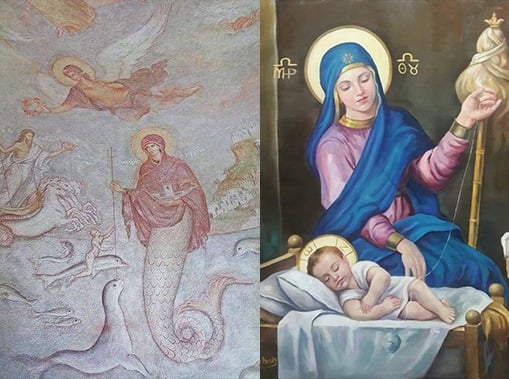
Holy Mount Athos is imbued with a profound sense of Our Lady's presence; the same presence that resonates throughout the lives of those who turn to Her. Her image permeates our existence, inspires, comforts and educates; sometimes directly, and sometimes through Her images, the holy icons.
.jpg) Her names are innumerable, as are Her images. Although most of them are very well known, there are some rare representations that often surprise and arouse the admiration of the believers.
Her names are innumerable, as are Her images. Although most of them are very well known, there are some rare representations that often surprise and arouse the admiration of the believers.
THEOTOKOS EGYMONOUSA (WAITING FOR THE BIRTH OF THE HOLY INFANT)
The icon of Theotokos Egymonousa is not a very well known one. Some theologists claimed that it is a heretical representation, as its type deviates from all known representations of the Mother of God. However, similar works can be found in Byzantine art from the 11th century onwards. The Divine Infant is usually depicted within a round medallion, symbolizing the Word of God incarnated in the womb of the Virgin Mary. It is not at all surprising that the icon of Theotokos Egymonousa helps pregnant women, as well as couples trying to have children. One of the few icons that follow this type is kept in the church of Saint Stylianos of the Greek city of Katerini.
THEOTOKOS GORGONA (THE MERMAID)
This particular representation of Our Lady is often found in Greece. However, believers from other countries or even locals from regions outside the Greek islands are surprised to see the Virgin Mary depicted as a mermaid..jpg)
Deeply impressed, the Greek poet Myrivilis wrote with great admiration about this unusual image, which, in turn, was inspired by a fresco in the chapel of the Theotokos on the island of Lesbos.
According to the type of Theotokos Gorgona, the Mother of God is represented from the waist up in human form, while from the waist down Her body acquires a fish tail, just like the mermaids of ancient Greek mythology.
The interpretation of the appearance of this depiction is probably related to the fact that the chapel of the Mother of God in Lesbos is located near a fishing village. The locals are likely to have combined, in this peculiar way, the Orthodox faith with their own traditions.
.jpg) THE FIRST STEPS OF JESUS CHRIST
THE FIRST STEPS OF JESUS CHRIST
The earliest depiction of this theme dates back to the 17th century and is located in the Holy Monastery of Limon of the island of Lesbos. It is striking that Jesus Christ is shown taking his first steps at the age of 2-3 years, rather than as an infant or as a very young child. He stretches out His hands to His Holy Mother, who joyfully leans over Him.
One possible explanation for the origin of this particular depiction is a reference to the Apocryphal Gospel of James. Its description of the early childhood of the Mother of God, as well as Her first seven steps, may have been the inspiration for a similar depiction of the childhood of Jesus Christ.
THEOTOKOS THE SPINNING
This icon depicts the Mother of God spinning threads as She lulls the Divine Infant in the cradle at Her feet. It is a Western-style representation, but it is also found in similar Byzantine works..jpg)
The icon is kept in the Patriarchal Monastery of Saint George in Cairo, where Jesus took refuge. It is considered to be rare because of its human-centered character. Our Lady is portrayed as a woman engaged in usual daily tasks. She knits to provide the necessary clothing and attends to her child sleeping beside Her.
Similar depictions of the Mother of God spinning are generally found in scenes of the Annunciation, where She is shown with the Archangel Gabriel.
This scene has a second, symbolic meaning revealed in the Great Canon of Saint Andrew of Crete:
"The spiritual purple of Emmanuel was woven inside thy womb as if from scarlet silk, O Most-pure Virgin. Therefore we honor thee as truly Theotokos."
The Divine Infant was thus "woven" with the flesh and blood of the Mother of God. This makes the image all the more important, since it does not represent visually the moment of the Annunciation, nor a symbolic interpretation of the nature of the Divine Child, but the Word already born, incarnate, lying in the cradle under the care of His Blessed Mother..jpg)
THEOTOKOS OF CHAROS FROM THE ISLAND OF LIPSI
The icon of the Theotokos of Charos is considered particularly rare, as it is the only image in which She is not holding the Divine Child in Her arms, but is tenderly embracing the Holy Cross. The icon is venerated with grace on the Greek island of Lipsi, located in the southeastern part of the country.
The Theotokos of Charos is named after the cross She carries in Her arms. Jesus is closely associated with the figure of Charos in ancient Greek mythology. The latter was the one who carried the souls of the dead to Tartarus, the subterranean realm of the dead in Hades. However, according to the Orthodox theological interpretation, the crucifixion gave birth to the hope of salvation, marking the entrance to eternal life, resurrection and victory over death.
The miraculous icon is kept in the monastery of the Virgin Mary on the island of Lipsi, one kilometer from the village of the same name. Both the icon and the monastery date back to the 1600s. The foundation of the monastery is attributed to two monks from Patmos, where, according to tradition, St. John the Theologian wrote the Gospel and the Book of Revelation.

